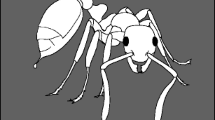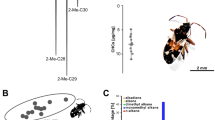Summary.
Colonies of two species of Metapone (M. madagascarica, M. new species.) were collected in Madagascar and established in laboratory nests. It could be demonstrated that both species are specialist predators of termites (Cryptotermes kirbyi). During hunting the ants sting the termites and thereby paralyze and preserve the prey alive. In this way prey can be stored in the ant nest for extended periods. During foraging and colony emigrations the ants lay chemical trails with poison gland secretions. Among the seven compounds identified in the venom only methyl pyrrole-2-carboxylate elicits trail following behavior in both Metapone species.
Similar content being viewed by others
Author information
Authors and Affiliations
Additional information
Received 11 February 2002, accepted 23 February 2002.
Rights and permissions
About this article
Cite this article
Hölldobler, B., Oldham, N., Alpert, G. et al. Predatory behavior and chemical communication in two Metapone species (Hymenoptera:Formicidae). Chemoecology 12, 147–151 (2002). https://doi.org/10.1007/s00012-002-8340-7
Issue Date:
DOI: https://doi.org/10.1007/s00012-002-8340-7




